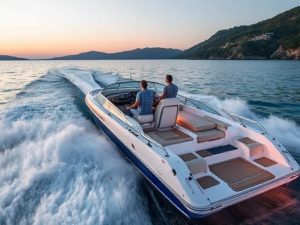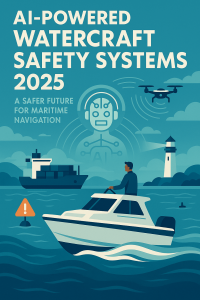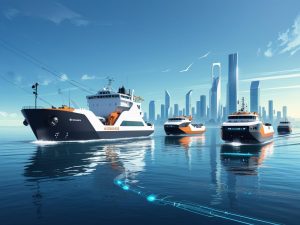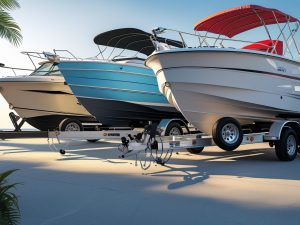In the ever-evolving world of transportation, marine technology is entering a golden age of transformation. As we step into 2025, futuristic boats and watercraft are no longer just imaginative sketches—they are becoming real, sustainable, and smarter than ever. From solar-powered yachts and electric ferries to hydrofoil surfboards and AI-driven navigation systems, the marine industry is embracing cutting-edge innovation that redefines how we move across water.
This article delves into the most groundbreaking futuristic boats and watercraft designs of 2025, highlighting features such as sustainability, automation, performance, and luxury. Whether you’re a maritime enthusiast, investor, or just curious about the future of marine travel, you’ll find this exploration both informative and exciting.
Why 2025 Is a Turning Point in Marine Transportation
The year 2025 marks a pivotal point in the evolution of boat and watercraft technology. Several key factors are driving innovation in this space:
-
Environmental regulations pushing the transition from diesel to electric.
-
Demand for smart, autonomous navigation to increase efficiency and reduce crew dependency.
-
Luxury market growth, with high-net-worth individuals seeking ultra-modern yachts.
-
Adoption of AI and IoT technologies for real-time diagnostics and safety.
-
Emergence of ride-sharing models on water, particularly in urban centers.
These trends are shaping an entirely new category of watercraft that are sleek, efficient, and eco-conscious.
Key Features of Futuristic Boats in 2025
1. Electric Propulsion Systems
Gas-guzzling engines are being replaced by zero-emission electric propulsion systems. Brands like Candela and X Shore are leading this transformation with boats that glide silently across the water, powered by lithium-ion or solid-state batteries.
-
Benefits: No exhaust fumes, reduced noise pollution, lower maintenance.
-
Challenges: Battery life, charging infrastructure, high initial costs.
Electric ferries are already operating in cities like Stockholm, and by 2025, even fishing vessels and patrol boats are transitioning to electric models.
2. Hydrofoils and Lift Technology
Hydrofoils are transforming the way boats interact with water. By lifting the hull above the surface, hydrofoils dramatically reduce drag, allowing for faster speeds and smoother rides.
-
Use Cases: High-speed commuter ferries, racing boats, recreational surfboards.
-
Example: The Candela C-8, which flies above the water at 30 knots with minimal wake and energy use.
Hydrofoil technology not only enhances performance but also improves energy efficiency, making it ideal for long-distance transport.
3. AI-Driven Autonomous Navigation
Autonomous marine navigation is becoming a reality thanks to artificial intelligence and real-time sensors. Companies like Sea Machines and ABB are developing AI systems that:
-
Map optimal routes in real-time.
-
Avoid collisions automatically.
-
Operate vessels without human input.
In 2025, expect to see autonomous cargo barges, remote-controlled rescue boats, and self-parking yachts becoming mainstream in the market.
4. Solar and Hydrogen Power Integration
Sustainability is at the core of futuristic boat designs. Beyond electric propulsion, boats are now integrating solar panels and hydrogen fuel cells to extend range and reduce environmental impact.
-
Solar Yachts: Brands like Silent Yachts have created fully solar-powered catamarans.
-
Hydrogen Boats: Aqua by Sinot Yacht Architecture uses hydrogen fuel cells for clean propulsion.
By 2025, many commercial and luxury boats will be equipped with multi-source energy systems.
5. Modular and Smart Interiors
Futuristic boats are not just about what’s under the hull—they are also redefining interior experiences.
-
Smart Controls: Touchscreens, voice assistants, and gesture recognition to control lighting, temperature, and entertainment.
-
Modular Furniture: Easily customizable for work, relaxation, or family time.
-
Eco Materials: Use of recycled materials, bamboo, and bio-composites in furnishings.
Yacht interiors in 2025 resemble luxury hotel suites—with panoramic views, solar blinds, and personalized lighting controlled via smartphones.
Leading Futuristic Boat Models in 2025
1. Candela C-8 Hydrofoil Boat
-
Power Source: Electric
-
Top Speed: 30 knots
-
Features: Hydrofoil lift, autonomous navigation, zero wake.
-
Price: Around $390,000 USD
The Candela C-8 is often referred to as the “Tesla of the sea,” combining efficiency, elegance, and tech.
2. Silent 62 Tri-Deck Yacht
-
Power Source: Solar-electric
-
Range: Unlimited sunlight-powered cruising
-
Features: Multiple decks, smart home systems, silent operation.
This yacht is designed for eco-conscious luxury, capable of crossing oceans with no emissions.
3. SeaBubbles Water Taxi
-
Type: Hydrofoil electric water taxi
-
Top Speed: 25 knots
-
Use Case: Urban mobility on rivers and lakes
This craft is already being tested in Paris and Geneva. By 2025, it’s projected to be in major urban centers worldwide.
4. Arkup 75 Livable Yacht
-
Type: Floating home/yacht hybrid
-
Power Source: Solar + battery
-
Features: Anchoring system, climate-resilient, modular rooms.
Arkup 75 is ideal for climate-conscious living on the water, blending sustainability with smart architecture.
5. Sea Machines SM300
-
Use Case: Remote command and control for commercial vessels
-
Technology: AI, GPS, LiDAR
-
Features: Self-docking, auto-navigation, obstacle avoidance
This is not a boat but a system transforming any boat into an autonomous vessel.
Applications of Futuristic Watercraft Designs
A. Urban Water Taxis
Cities like Amsterdam, Venice, and Bangkok are investing in futuristic electric ferries and water taxis to reduce road congestion and emissions.
B. Search and Rescue Missions
Autonomous boats with thermal cameras and GPS can perform quick-response missions without endangering human lives.
C. Tourism and Eco-Cruising
Silent, electric boats provide an immersive experience for tourists without disrupting marine life or polluting waterways.
D. Luxury Exploration
Wealthy individuals are commissioning custom-built yachts with AI, solar power, and submersibles for underwater exploration.
Sustainable Materials and Design Trends
The marine industry is adopting eco-friendly materials in 2025, including:
-
Recycled carbon fiber for hulls.
-
Biodegradable composites for interiors.
-
Non-toxic anti-fouling paints that reduce water pollution.
-
LED lighting systems to minimize energy usage.
Designers are also emphasizing aerodynamic exteriors and modular systems that allow vessels to be repurposed or resold with ease.
Smart Technology Integration in Boats
Smart systems are becoming standard in futuristic boats:
-
AI Navigation: Calculates best route, adjusts for weather.
-
IoT Diagnostics: Monitors engine health and battery performance.
-
Remote Access: Owners can monitor and control systems via apps.
-
Augmented Reality Dashboards: For enhanced navigation.
These features offer enhanced safety, better fuel efficiency, and a luxury experience.
Challenges and Future Prospects
Despite the progress, several challenges remain:
-
High production costs for new technologies.
-
Limited charging infrastructure in remote regions.
-
Regulatory approval for autonomous boats.
However, by 2025 and beyond, increased investment, global cooperation, and innovation are expected to make futuristic watercraft more accessible and widespread.
How to Invest in the Future of Marine Technology
If you’re an investor or marine entrepreneur, here are ways to get involved:
-
Stock investments in companies like Brunswick Corp., X Shore, or Navier.
-
Startups focusing on autonomous navigation or battery systems.
-
Marinas and charging infrastructure for electric boats.
-
Eco-tourism businesses using futuristic boats for immersive experiences.
The marine technology sector is poised for exponential growth and long-term profitability.
Frequently Asked Questions (FAQs)
1. What is the most futuristic boat design in 2025?
The Candela C-8 is among the most futuristic designs, featuring electric hydrofoil technology, AI-powered autopilot, and zero emissions.
2. Are electric boats better than diesel-powered boats?
Yes. Electric boats are cleaner, quieter, and require less maintenance. However, they currently have shorter ranges and higher upfront costs.
3. How much does a solar-powered yacht cost?
Depending on size and luxury, a solar-powered yacht like the Silent 60 can cost between $2 million and $3.5 million.
4. Will autonomous boats become legal in 2025?
Autonomous boats are already in use under pilot programs. Regulatory bodies are working on frameworks, and full legality in commercial zones is expected in stages through 2025 and 2026.
5. Can I retrofit my current boat with futuristic tech?
Yes, certain systems like electric motors, solar panels, and smart controls can be retrofitted into traditional boats depending on size and configuration.
6. What are hydrofoil boats used for?
Hydrofoil boats are used for high-speed commuting, racing, and luxury experiences due to their efficiency and smooth ride.
7. Is marine transportation going fully electric by 2025?
Not fully, but a large portion of recreational and urban transport vessels will be electric or hybrid by 2025.
8. Are futuristic boats safe?
Yes. Most futuristic boats feature advanced safety systems such as GPS-based geofencing, collision sensors, and automated distress alerts.
Conclusion
The future of marine transportation is incredibly promising, and 2025 is already witnessing the dawn of next-generation boats and watercraft. From electric hydrofoils to solar-powered yachts and AI-driven vessels, the industry is undergoing a transformation fueled by innovation, sustainability, and luxury.
These futuristic designs are more than just technological marvels—they represent a shift toward a cleaner, smarter, and more enjoyable way to travel on water. Whether you’re a city commuter, a thrill-seeking adventurer, or a billionaire yacht owner, the future of watercraft has something for everyone.





